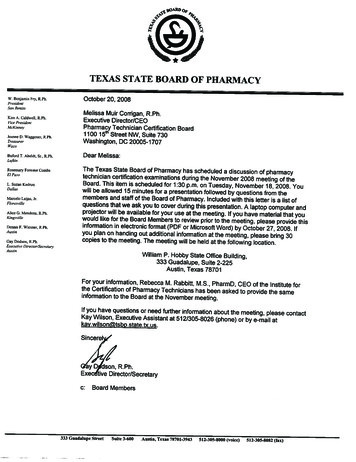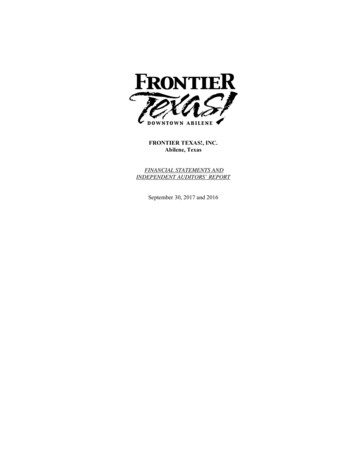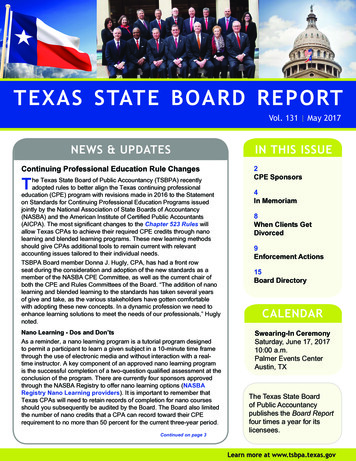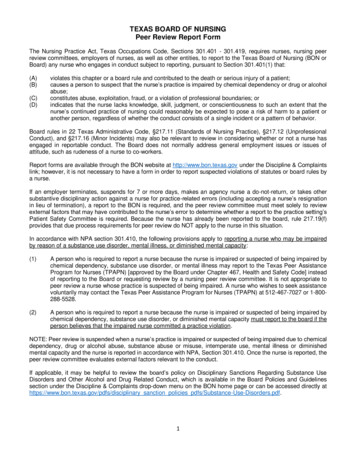
Transcription
Texas State Board of PharmacyBoard MeetingAustin, TexasNovember 18 to 19, 2008Table of ContentsI.Presentation on the Pharmacy Technician Certification Board and the Pharmacy TechnicianCertification Exami. Texas PTCB Candidate Demographics, January 1, 2007 to October 10, 2008 (Slide 7)ii. APhA/ASHP Letter to the Editor on the Importance of Establishing a Single NationalStandard for Pharmacy Technician Certification, July 29, 2008 (Slide 11)iii. NABP Memo on Technician Certification Examinations, September 9, 2008 (Slide 13)iv. NABP Memo on Technician Certification Examinations, April 24, 2008 (Slide 13)v. PTCB Map as of September 30, 2008 (Slide 17)II.Responses to Questions from the Texas State Board of Pharmacyi. Appendix I, National & Texas Examination Statistics, 1995 to September 26, 2008(Questions 5, 6, and 7)ii. Appendix II, Content Outline of the Pharmacy Technician Certification Exam (PTCE)(Question 12b)iii. Appendix III, PES Security Procedures (Question 12c)iv. Appendix IV, PTCE Psychometric Data (Question 14)
History of PTCBThe Pioneer for Pharmacy Technician CertificationPTCB Certification:A Single Standard for PharmacyTechnician CertificationTexas State Board of PharmacyBoard MeetingAustin, TXNovember 18 to 19, 2008PTCB was established in January, 1995, as a not-for-profitorganization to create a single consolidated nationalcertification program applicable to pharmacy technicians in allpractice settings. Through the PTCB program, pharmacytechnicians are able to work more effectively with pharmaciststo offer safe and effective patient care and service.Governing Organizations: American Pharmacists Association (APhA) American Society of Health-System Pharmacists (ASHP) Illinois Council of Health-System Pharmacists (ICHP) Michigan Pharmacists Association (MPA) National Association of Boards of Pharmacy (NABP)Melissa Murer Corrigan, R.PhExecutive Director/CEOPharmacy Technician Certification Board2PTCB, the nationallynationally-recognized pioneerof pharmacy technician certificationTexas Employers SupportPTCB CertificationPTCB pioneered the implementation of uniform formalizedstandards for pharmacy technicians for the purpose ofprotecting public health.AlbertsonsCardinal HealthCVS/PharmacyHealth-SystemsSince 1995 the five governing organizations have heavilyinvested in the development of PTCB and the PharmacyTechnician Certification Examination (PTCE) process.KmartU.S. MilitaryyTarget PharmacyRemington CollegePTCB certification is a solution which may help resolve orprevent medication errors and enhance patient safety.WalgreensPTCB has certified over 322,000 pharmacy technicians.34Testing Sites in TexasPTCB and Texas61
Texas Pharmacy TechniciansTexas SpecificationsTexas StatisticsGrowth of the PTCB Exam1995 - 2000 Candidates: 22,0382001 – Present* Candidates: 67,263Percent Increase: 205%PTCB Exam Texas StatisticsExam DateTotalCandidatesPassingCandidatesPassing Rate1995 Exams58846779%1996 Exams74557577%1997 Exams1,18195281%CPhTs Currently Active38,346Current retention rate70.1%1998 Exams2 4882,4881 9651,96579%Community Chain: 30%Community Independent: 14%Hospital: 9%Education and Training: 14%Mail Service, Home healthcare, long-termcare, and managed healthcare: 7%Military: 25%Other Settings: 1%1999 Exams4,9773,98680%2000 Exams12,0599,10375%2001 Exams7,4095,11969%2002 Exams7,0335,04272%2003 Exams7,8045,63472%Practice Settings-2007 throughOctober 15, 2008* As of 10/15/087PTCB State AssociatesPTCB Exam Texas StatisticsExam DateTotalCandidatesPassingCandidates2004 Exams9,2506,34869%2005 Exams10,1246,86068%54%Passing Rate2006 Exams10,1405,4532007 Exams8,5645,00158%2008 Feb 4 to Mar. 141,47082856%2008 April 28 to June 202,7951,69561%2008 Aug. 18 to Sept.26Totals2,6741,52557%89,30160,55368%Texas Pharmacy AssociationTexas Society of Health-System PharmacistsThe Texas Pharmacy Association and the Texas Societyof Health-System Pharmacists support the PharmacyTechnician Certification Board (PTCB) Examinationas the exclusive mechanism to test and certifytechnicians for the state of Texas.10APHA/ASHP Letter to the EditorJuly 29, 2008PTCB is the nationally recognizedpioneer of pharmacy techniciancertification, ensuring formalizedstandardst d d ini ththe pharmacyhworkforce through a nationallyaccredited certification program.To the Editor:“Establishing a single standard for pharmacy techniciancertification through PTCB is consistent with the approach usedprofessions,f, as well as the approachpputilized withinbyy other health pthe profession for the accreditation of educational institutions andthe pharmacist licensure process. NABP performed a psychometricaudit of the PTCB’s PTCE in 2001 and determined that the PTCEis psychometrically sound, defensible, and valid.”This paragraph was excerpted from the letter written by John A. Gans,PharmD., Sc.D, and Henri R. Manasse, Jr., Ph.D., Sc.D.122
National Pharmacy Organization Supportfor Pharmacy TechniciansTwelve National Organizations recognize pharmacytechnicians and their role in assisting pharmacists.These organizations include recommendations fortraining, education, certification, and regulation ofpharmacy technicians in their adopted policies or samplees. OrganizationsO ga a o s includingcg PTCBC in theire policypo cy oorrules.sample rules: American Pharmacists Association American Society of Health-System Pharmacists National Association of Boards of Pharmacy American College of Clinical Pharmacy13NABP Evaluates Technician ExamResulted in official partnership (1/1/2002) with PTCB.– NABP assists in development and management ofexam– Carmen A. Catizone, Chair of PTCB CertificationCCouncilil– NABP officially recognizes PTCB exam in ModelState Pharmacy Act and Model Rules– NABP encourages use by state boards14Support of State BoardsPTCB assists state boards of pharmacyto develop and implement uniformstandards for pharmacy technicians forthe purpose of protecting public health. PTCB Supports Electronic Reporting ofCertification Status Coordination and Communication ofDisciplinary Actions PTCB Provides Free School Reports asOutcome Data to Assist Training Programs Developed Additional Practice Tests in ContentAreas to Support New Regulations16State Regulations and PTCBActive PTCB CPhTs and State Regulationsas of September 30, 2008The PTCE is administered in all 50 states, Guam, andPuerto Rico. According to the 2008 NABP Survey ofPharmacy Law, 37 states regulate pharmacytechnicians, with 28 states incorporating PTCB intotheir regulations in one of the following ways:– As a requirement for pharmacy technician stateregistration or licensure.– As one of the ways to meet state requirements forpharmacy technician registration or licensure.– As a mechanism for expanded pharmacist topharmacy technician ratios.173
PTCB, Pearson VUE, and PESPharmacyy TechnicianCertification ExaminationWorking together proactively toimplement a reliable, psychometrically‐sound, and legally defensiblecertification program for pharmacytechnicians.20Testing Vendors Pearson VUE– Founded in 1994– Global leader in electronic testing services for academic,regulatory, certification, and licensure programs– Specializes in delivering high-stakes examinations in asecure, first-class testing environment– World’s largestgnetwork of test centers in 162 countriesProfessional Examination Services (PES)– Founded in 1941– Examination development vendor since 1995– Supports professional licensure and certification, training,and continuing professional education– Offers a full-range of assessment and testing servicesPsychometrically-soundPsychometricallyPTCB National Testing Based on national study of pharmacypractice, including participants from each stateacross all practice settings. Breadth and depth of exam, designed andupdated by over 60 subject matter experts, testsa minimum level of competency forpharmacy technician certification. Item writers represent all areas of pharmacy Item writer workshops enhance writer’s ability to generateeffective items for the exam22Psychometrically-soundPsychometricallyPTCB National Testing Allows for reciprocity among states. Nationally-administered exam for thirteenyears: 400,000 administrations. Meets and exceeds standards set by thetesting industry (AERA/NCME/APA, 1999). Average KR20 Score of 0.90, indicates highreliability and validity PTCB certification program isaccredited by the NCCA.PTCE Content OutlineTest specifications are based on PTCB’s recent practiceanalysis and reflect the revised percentage weights ofpharmacy technician functions as follows: AAssistingi ti ththe PhPharmacisti t iin SServingi PPatientsti t - 66% Medication Distribution and Inventory ControlSystems - 22% Participating in the Administration andManagement of Pharmacy Practice - 12%234
PTCB Testing Continuous testing in 2009Official Score results in 1-3 weeksProfessional, state-of-the-art, distraction-free testingcentersOver 200 Pearson Professional Centers NationwideOver 75 Pearson-approved DANTES CentersThe Pearson Testing ExperienceA Consistent Testing Experience Across the Pharmacy Profession– Pearson VUE delivers exams for NABP through its Pearson Professional Centers: : North American Pharmacist Licensure Examination (NAPLEX ) Multistate Pharmacy Jurisprudence Examination (MPJE )– Pearson VUE delivers the PTCB Pharmacy Technician Certification Exam (PTCE)at the same test centers used by NABP.– Pearson developsp the Pharmacyy Collegeg Admission Test ((PCAT),), endorsed byy theAmerican Association of Colleges of Pharmacy (AACP)Future Testing DatesNov. 10 - Dec. 19, 2008Jan. 5 – March 31, 2009April 1, 2009 – Continuous Testing2526Test Center SecurityPearson Professional Centers provide the highest degree ofconsistency, security, and control in the industryTest Site Security– Private lockers, server room, testing room– Uniform test site setup and designCandidate Identification– Digital fingerprint, signature, andphotograph technology– Customized check-in proceduresCandidate Monitoring– Digital audio and visual recording of eachexam session– Patented design provides direct line of sightto all candidatesSite MonitoringIn Tribute to Larry Nesmith, CPhTPharmacy Technician EducatorAcademy of Health SciencesAMEDD Center & SchoolFt. Sam Houston, San Antonio, Texas“ a true friend of pharmacy. Larrymade significant contributions to theadvancement of pharmacy techniciansas an educator and CPhT.He will be missed.”Question andAnswer SessionContact InformationMelissa Murer Corrigan, RPhExecutive Director/CEOPharmacy Technician Certification Board1100 Fifteenth Street, NW, Suite 730Washington, DC 20005Phone: 202-429-7566Email: mmc@ptcb.orgFax: 202-429-7596(1943 to 2008)-Melissa Murer Corrigan, RPh, Executive Director/CEO29305
Texas PTCB Candidate DemographicsJanuary 1, 2007 through October 10, 2008AgeUnder 21 years – 39%21-30 years – 37%31-40 years – 13%41-50 years – 7%51-60 years – 3%Over 60 years 1%n 8,685GenderFemale – 70%Male – 30%n 9,739In total, how long have you worked full and/or part-time as a pharmacy technician?Less than 6 months69%6 months-1 year17%2-3 years7%4-5 years3%6-10 years3%11-20 years1%n 7,939What is your highest level of education?High school diploma/equivalency26%Associate’s degree5%Bachelor’s degree5%Master’s degree1%Pharmacy technician certificate/diploma of completion63%n 535
Did you complete a pharmacy technician training program?Yes, it was an accredited program43%Yes, but it was not an accredited program8%Yes, but I don’t know whether the program was accredited or notaccredited15%No, I did not participate in a pharmacy technician training program32%Other2%n 8,778Please select the primary method for your training as a pharmacy technician.Educational Institution42%Formal on-the-job training program developed and provided byemployer14%Informal on-the-job training provided by employer16%Military Training Program1%Other27%n 9,127What is your primary area of work?Assisting in outpatient prescription dispensing38%Assisting in inpatient medication dispensing10%Preparing IV admixtures3%Purchasing/Inventory ng2%Other43%n 4,031
What is the name of your 2%Safeway1%Target2%Walgreens21%Walmart1%Not Listed57%n 4,939Does your employer recognize CPhTs with expanded job duties and/or employmentopportunities?Yes – 25%No – 8%I don’t know – 67%n 4,177Does your employer recognize CPhTs with higher pay rates?Yes – 42%No – 8%I do not know – 50%n 8,983
July 29, 2008To the Editor:Medications continue to be a significant and vital component of medical care. And while thecomplexity and scope of medication use continues to grow, the role of pharmacists in caring forpatients is expanding to help meet patient needs for safe and effective care. In addition to thisimportant role for pharmacists, it is clear that safe medication use systems also require thesupport of well-qualified and competent pharmacy technicians. Recent reports in the media oftragic errors only serve to reinforce this point. This letter is intended to reinforce the position ofboth the American Pharmacists Association (APhA) and the American Society of Health-SystemPharmacists (ASHP) regarding the role of pharmacy technician certification in assuring thatindividuals have demonstrated a professionally recognized level of competence in the handlingand preparation of medications.Both APhA and ASHP have established professional policy on the importance of pharmacytechnicians supporting the professional imperative of pharmacists in helping people make thebest use of medicines. Pharmacists and the public require assurance that pharmacy techniciansare qualified to handle the tasks that are delegated to them. We believe it will be difficult forpharmacy to achieve its vision for pharmacist practice unless the profession adopts uniformnational standards for pharmacy technician education, training, certification and registration.The pharmacy technician is accountable to the supervising pharmacist who is legally responsiblethrough state licensure for the care and safety of patients served by the pharmacy.We continue to believe it is important that there be a single national standard for pharmacytechnician certification that is recognized and supported by the profession. The PharmacyTechnician Certification Board (PTCB) has served this role since it was established in 1995. Todate, more than 300,000 pharmacy technicians have been certified by PTCB. Pharmacytechnicians have been certified in virtually all practice settings, including community pharmacy,hospitals and health systems, long-term care, and others.PTCB is a non-profit organization governed by five pharmacy organizations, including APhA,ASHP, National Association of Boards of Pharmacy, Michigan Pharmacists Association, andIllinois Council of Health-System Pharmacists. These organizations have invested heavily in thedevelopment of PTCB and the Pharmacy Technician Certification Examination (PTCE) process.They have commissioned successive analyses of pharmacy technician practices by subject-matterexperts from diverse practice settings and geographic locations to ensure the comprehensivenessand currency of the PTCE. PTCB is accredited by the National Commission for CertifyingAgencies, which has established rigorous standards for certification programs. PTCB has alsohad a long-standing relationship with Professional Examination Service to ensure the
Page 2.Drs. Gans and ManasseLetter to the Editorpsychometric integrity and validity of the PTCE. Through its strategic partnership with PearsonVUE, PTCB is able to offer highly scalable, computer-based testing through the world’s largestnetwork of testing centers. PTCB is highly regarded not only within the profession, but also inthe broader certification community, for its high standards in the certification of pharmacytechnicians. Its partnerships with state pharmacy associations and major employers of pharmacytechnicians are innovative and ground-breaking in the certification field. In short, PTCB's PTCEis the pharmacy profession's program for assuring the qualifications and competence ofpharmacy technicians.Establishing a single standard for pharmacy technician certification through PTCB is consistentwith the approach used by other health professions, as well as the approach utilized within theprofession for the accreditation of educational institutions and the pharmacist licensure process.NABP performed a psychometric audit of the PTCB’s PTCE in 2001 and determined that thePTCE is psychometrically sound, defensible, and valid.Attached you will find specific APhA and ASHP policies related to pharmacy technicians.We call on the profession to support this single standard for pharmacy technician certification.Sincerely,John A. Gans, Pharm.D., Sc.D.Executive Vice President and CEOAmerican Pharmacists AssociationHenri R. Manasse, Jr., Ph.D., Sc.D.Executive Vice President and CEOAmerican Society of Health-System Pharmacists
APhA Policy on Pharmacy Technicians:2008 Pharmacy Technician Education and Training1. APhA reaffirms the 2005/2001/1996 Control of Distribution System policy which states thatAPhA supports pharmacists’ authority to control the distribution process and personnelinvolved and the responsibility for all completed medication orders, regardless of practicesetting.2. APhA supports nationally recognized standards and guidelines for the accreditation ofpharmacy technician education and training programs.3. APhA supports the continued growth of accredited education and training programs thatdevelop qualified pharmacy technicians who will support pharmacists in ensuring patientsafety and enhancing patient care.4. APhA supports the following minimum requirements for all new pharmacy technicians by theyear 2015:a. Successful completion of an accredited education and training programb. Certification by the Pharmacy Technician Certification Board (PTCB).5. APhA supports state board of pharmacy regulation that requires pharmacy technicians to meetminimum standards of education, training, and certification. APhA also encourages stateboards of pharmacy to develop a phase-in process for current pharmacy technicians.2004 Pharmacy Technicians1. APhA supports certification of pharmacy technicians by the Pharmacy TechnicianCertification Board to advance the position as a career within pharmacy practice.2. APhA urges pharmacists to provide guidance and training to pharmacy technicians.Pharmacists and employers are urged to provide on-going training support opportunities.3. APhA supports state boards of pharmacy regulating all pharmacy technicians. Suchregulations must require pharmacist oversight of personnel involved in pharmacy services.2004 Technician Licensure and RegistrationAPhA recognizes, the following definitions with regards to technician licensure and registration;(a) Licensure: The process by which an agency of government grants permission an individual toengage in a given occupation upon finding that the applicant has attained the minimal degree ofcompetency necessary to ensure that the public health, safety, and welfare will be reasonablywell protected. Within pharmacy, a pharmacist is licensed by a State Board of Pharmacy.(b) Registration: The process of making a list or being enrolled in an existing list.
ASHP Policy on Pharmacy TechniciansPolicy 0815 - Uniform State Laws and Regulations Regarding Pharmacy Technicians:To advocate that pharmacy move toward the following model with respect to techniciansas the optimal approach to protecting public health and safety: (1) development andadoption of uniform state laws and regulations regarding pharmacy technicians; (2)mandatory completion of an ASHP-accredited program of education and training as aprerequisite to pharmacy technician certification; and (3) mandatory certification by thePharmacy Technician Certification Board as a prerequisite to the state board of pharmacygranting the technician permission to engage in the full scope of responsibilitiesauthorized by the state; further,To advocate registration of pharmacy technicians by state boards of pharmacy; further,To advocate, with respect to certification, as an interim measure until the optimal modelis fully implemented, that individuals be required either (1) to have completed an ASHPaccredited program of education and training or (2) to have at least one year of full-timeequivalent experience as pharmacy technicians before they are eligible to becomecertified; further,To advocate that licensed pharmacists be held accountable for the quality of pharmacyservices provided and the actions of pharmacy technicians under their charge.(Note: Certification is the process by which a nongovernmental agency or associationgrants recognition to an individual who has met certain predetermined qualificationsspecified by that agency or association. Registration is the process of making a list orbeing enrolled in an existing list; registration should be used to help safeguard the publicthrough interstate and intrastate tracking of the technician work force and preventingindividuals with documented problems from serving as pharmacy technicians.)
228TO:EXECUTIVE OFFICERS – STATE BOARDS OF PHARMACYFROM:Carmen A. Catizone, Executive Director/SecretaryDATE:September 9, 2008RE:Technician Certification ExaminationsRecently you received an announcement from the Institute for the Certification of PharmacyTechnicians (ICPT) noting that their Exam for the Certification of Pharmacy Technicians (ExCPT)examination received accreditation from the National Commission for Certifying Agencies(NCCA). That announcement and requests from ICPT to appear before various boards of pharmacyand gain recognition of the ExCPT generated some questions to NABP. The most frequent questionposed to NABP concerned NCCA accreditation.As NABP noted in its April 2008 memorandum to the boards, accreditation by NCCA represents anaudit by certification experts commissioned by the National Organization for CompetencyAssurance (NOCA) and ascertains that an accredited program adheres to accepted standards in thecertification industry. States inquired if the NCCA accreditation awarded to ICPT’s program wassimilar to the accreditation conferred on the Pharmacy Technician Certification Examination(PTCE) and certification program developed and administered by the Pharmacy TechnicianCertification Board (PTCB). The accreditations of both PTCB and ICPT are from NCCA. If statesrefer to NCCA accreditation as a means of recognizing certification programs for technicians thenboth programs would satisfy this requirement.NABP was also asked if it had conducted an independent assessment of either program. NABPconducted an independent assessment of the PTCB certification program, which resulted in NABP’sendorsement of the PTCB program. NABP’s partnership with PTCB is pursuant to the actiondirected by the member boards in Resolution No. 96-1-2000. NABP’s collaboration with PTCB alsoadheres to the restrictions placed upon NABP because of its educational and charitable designation(501 C-3) afforded NABP by the Internal Revenue Service. This designation restricts NABP’saffiliations with for profit corporations. PTCB is a 501 C-6 organization.If you have any questions or comments regarding this matter you may contact me via phone at847/391-4400 or via e-mail at exec-office@nabp.net.cc:NABP Executive CommitteeMelissa Corrigan, PTCBRebecca Rabbit, ICPT
TO:EXECUTIVE OFFICERS – STATE BOARDS OF PHARMACYFROM:Carmen A. Catizone, Executive Director/SecretaryDATE:April 24, 2008RE:Technician Certification ExaminationsA number of boards of pharmacy have once again contacted NABP requesting information forevaluating proposals for examinations that assess pharmacy technicians. To date, NABP has notreceived any information, from any source, concerning the validity or psychometric soundness ofany technician examination beyond Pharmacy Technician Certification Board’s (PTCB) PharmacyTechnician Certification Examination (PTCE).NABP adheres to recognized and valid psychometric standards in preparing licensure andcertification examinations, NAPLEX, MPJE, FPGEE and the recently introduced, PharmacyCurriculum Outcomes Assessment (PCOA). NABP examined the PTCB’s PTCE through apsychometric audit conducted in the fall of 2001. The audit determined that the PTCE ispsychometrically sound, defensible, and valid. The methods used to construct the PTCE followtesting procedures recommended in the Standards for Educational and Psychological Tests (APA,NCME, AERA; 1999), guidelines published by the National Organization for CompetencyAssurance (NOCA), Council on Licensure, Enforcement, and Regulation (CLEAR). After NABP’sindependent assessment of the PTCE, NABP became a member of the PTCB Board of Governorspursuant to Resolution 96-1-2000, which directed NABP review existing technician assessmentprograms and in conjunction therewith, “develop a national competence assessment program toassess the competencies necessary for technicians to safely assist in the practice of pharmacy”.NABP’s partnership with PTCB generates revenue for the Association which is used to supportservices and programs for the boards of pharmacy.
EXECUTIVE OFFICERS – STATE BOARDS OF PHARMACYApril 24, 2008Page 2NCCA AccreditationNABP fully supported PTCB seeking accreditation by the National Commission for CertificationAgencies (NCCA). In 2007, the PTCB Certification Program was accredited by NCCA whichrepresents an independent audit by certification experts and ensures that PTCB’scertification program adheres to current standards of practice in the certification industry.The following information details critical standards that must be addressed by any examinationprogram in order for the examination to be valid and defensible.Practice AnalysisConducting a Practice Analysis is the first step of the examination validation process. Sometimesreferred to as a Job or Task Analysis, the Practice Analysis is a survey, study, and determination toidentify the knowledge and skills needed by entry level practitioners. The Practice Analysesconducted by NABP and PTCB for their examination and certification programs are alwaysnational studies that delineate the tasks engaged in by pharmacists and technicians and thecriticality of those tasks to the protection of the public health. Follow-up questions would concernthe time of the most recent Analysis, methodologies utilized, and final determinations. The Boardshould also request a copy of the most recent Practice/Job Analysis.Test Blueprint/SpecificationsThe test blueprint is a detailed, written plan for a test that typically includes descriptions of thetest’s purpose and target audience; the content or performance areas it will cover; the number andtypes of questions to be written for each content or performance area, their scoring, and othercharacteristics; the test administration method; and desired psychometric characteristics of theitems and the test. Test blueprints and competency statements should be developed usingpsychometrically sound procedures based upon the results of the national Practice Analysis. Thetest blueprint and competency statements should be readily provided and also distributed to thecandidates upon request. The Board should be able to discern the relationship between the testblueprint and the Practice Analysis.Item Writing ProceduresTechnically sound and recognized testing standards for writing test questions or items should beemployed. Item writers should be experts in the practice areas identified by the test specifications.Each item writer should undergo significant training, by item writing experts, as part of the itemwriting and validation process. The Board should request information about the item writingprocess, selection and qualification of items writers, and success of the item writing activities.Exam Items and QuestionsTest questions developed through the item writing process should be validated for use throughintense content and practice expert review and field testing processes. Information about the itemwriters and item writing process should be provided as part of the regular reporting. Multiplechoice questions are recommended for licensure and certification examinations. True and false andfill-in-the blank questions are problematic and generally not recommended for use by testdevelopment experts.
EXECUTIVE OFFICERS – STATE BOARDS OF PHARMACYApril 24, 2008Page 3A sufficient item bank of questions is necessary in order for the examination to be robust and avoidoverexposure of items. The Board should ask questions about all dimensions of the item pool andhow items are field tested and selected for inclusion in examinations.Description of Test Assembly ProceduresTest assembly procedures should follow sound psychometric standards and be regularly reported.An examination cannot be assembled without adhering to psychometric and content parameters. Anycertification or licensure examination used by the Board to determine which candidates can practiceor not, must demonstrate consistency between administrations, correlate to the passing score andPractice Analysis findings, and discriminate between candidates who perform well and candidateswho perform poorly. The Board should ask prospective examination providers about how suchobjectives are achieved and about the construction of all examinations.Number of Test Forms Used Per AdministrationSome examinations offer a number of test forms at each administration to reduce the exposure ofitems and deter candidate cheating. Each test form should meet established testing standards and beassembled according to the test specifications. In order to maintain the number of test forms, robustitem pools should be assembled, preferably containing many items the number of questions needed
I. Presentation on the Pharmacy Technician Certification Board and the Pharmacy Technician Certification Exam i. Texas PTCB Candidate Demographics, January 1, 2007 to October 10, 2008 (Slide 7) ii. APhA/ASHP Letter to the Editor on the Importance of Establishing a Single National Standard for Phar











